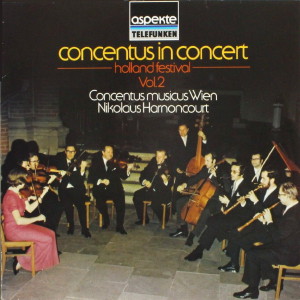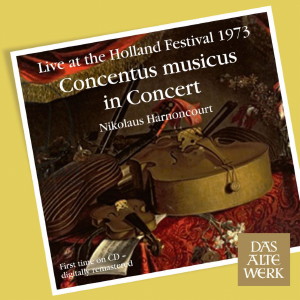 |
1 LP -
6.42072 AH - (p) 1979
|
 |
| 1 CD -
2564 66211-9 - (c) 2012 |
|
concentus in concert -
holland festival - Vol. 2
|
|
|
|
|
|
|
|
| Jean-Philippe Rameau
(1683-1764) |
|
|
|
| Suite aus der Oper "Castor et
Pollux" |
|
21' 10" |
A |
- Ouverture: Fièrement -
Vite
|
3' 17" |
|
|
| - Menuet I |
1' 26" |
|
|
| - Tambourin |
0' 52" |
|
|
| - Loure |
2' 12" |
|
|
| - Gavotte |
2' 41" |
|
|
| - 3e Air pour les athlètes |
1' 04" |
|
|
| - Entrée d'Hébé |
1' 55" |
|
|
| - Entrèe des astres -
Chaconne |
8' 05" |
|
|
|
|
|
|
| Heinrich Ignaz Franz Biber
(1644-1704) |
|
|
|
| Drei Sonaten aus "Fidicinium
sacro-profanum": |
|
17' 30" |
B |
| - Sonata No. 1 in B minor,
C. 78 |
7' 08" |
|
|
| - Sonata No. 8 in B flat
major, C. 85 |
4' 41" |
|
|
| - Sonata No. 10 in E major,
C. 87 |
5' 17" |
|
|
|
|
|
|
CONCENTUS MUSICUS
WIEN (mit Originalinstrumenten)
|
|
| Nikolaus
Harnoncourt, Leitung |
|
|
Luogo
e data di registrazione
|
| Lutherse Kerk,
Den Haag (Olanda) - 26 giugno 1973 |
|
Registrazione
live / studio
|
| live |
Producer
/ Engineer
|
-
|
Prima Edizione CD
|
Teldec
"Das Alte Werk" - 2564 66211-9 - (1 cd)
- 73' 37" - (c) 2012 - ADD
|
Prima
Edizione LP
|
Telefunken
"aspekte" - 6.42072 AH - (1 lp) -
38'
40"
- (p) 1979
|
|
|
Notes
|
Anybody hearing the
Concentus musicus Wien with
Nikolaus Harnoncourt in a concert for
the first time
is surprised. The reasons for
this are firstly that he
gains a new impression such as can
only result from direct confrontation
- the impression of spontaneous,
explosive music-making engendered by
the utmost degree of concentration,
the perfect opposite to the "studio
atrnosphere".
Secondly because the listener, if he
had only experienced gramophone
recordings, almost unexpectedly feels
that his expectations have been
confirmed. This is not a case of music
being perforrned on old instruments by
a philologist or historian in
accordance with traditional
perspectives, but a performance
rendered with enthralling emotion by a
present-day musician of flesh and
blood. That Harnoncourt is primarily a
musician, marked by a rich dash of the
musicmaker, has been appreciated by
many friends of early music for the first
time in a concert of such spirit-stirring
liveliness as is
actually the case with Harnoncoun. The
"hairsplitting"
- or more exactley the gathering of
knowledge - is part of a primary stage
going back a long way before the
concert.
This second gramophone disc, which was
recorded directly from a concert, transmits
that breath of the
fascinating element of the immediate
From this vantage point it can be that
one hears the other versions, the
studio productions, in a fresh manner,
since one so to speak subsequently
projects into them this particular
elementary factor. This impression
becomes especially important with
regard to works with which we
are not very farnilarand which bear
the stigma of being boring. This is particularly
so regarding music by Jean-Phihppe
Ramaeu. Harnoncourt is of the opinion
that Rameau's
operas are among the highlights of
French music and have been widely
underrated. The reason is
perhaps that as opposed
to other countries, in France singing
played a role which was not
indebted to Italian bel canto.
Rameau did not go to Paris until he
was 40 years of age, and at 50 began
to write operas with which he defended
the French tradition against the
influence of the Italians. He
created works which admittedly were
intended to be anti-revolutionary but
the effect of which was avantgarde,
due to Rameau's unusual ideas and his
enormous powers of expression. With "Castor
and Pollux", composed in 1737
and his second opera, he
anticipated the early classic - or,
as Harnoncourt opines - enabled
us to refer to the much sought after
link between baroque and the classical
period.
In view of the fact that frequently
only sketches have been preserved (of
the overture for instance there are
merely two lines and instrumental
references) .the interpreter of today
is forced to try, with a great deal of
understanding and imagination, to
bring about an approximate
tonal, dynamic and properly articulated
reproduction. This
will only entirely succeed where the
archaeological element of musical
preparation is forgotten and the
imagination is directly fired in the
concert performance - as was the case
at the recorded concert of the Holland
Fesuval in1973.
Heinrich Ignaz Franz
Biber was described by Paul Hindemith
as the most important musician of the
baroque era beside Bach. From the
point of view of tonal invention,
illustrative emotional discoveries,
the genial, effervescent
force, and also with his wit
and his diverse forms, the Austrian
was in fact, a highly interesting
composer. This applies particularly to
the violin, "his"
instrument, with which the Bohemian
musician became famous from his
base in Salzburg where he
had settled. The
short sonatas from the collection
entitled "Fidicinium
sacro-profanum" use
two violins, trombone and
basso continuo (in the 8th sonata for
example), written on the Italian
pattern, partly in luxuriating tutti,
tightly woven, partly
in solo concerto style, without
omitting indendent cadenzas.
W. E. v.
Lewinski
English translation by
Frederick A. Bishop
|
|
Nikolaus
Harnoncourt (1929-2016)
|

|

|
|